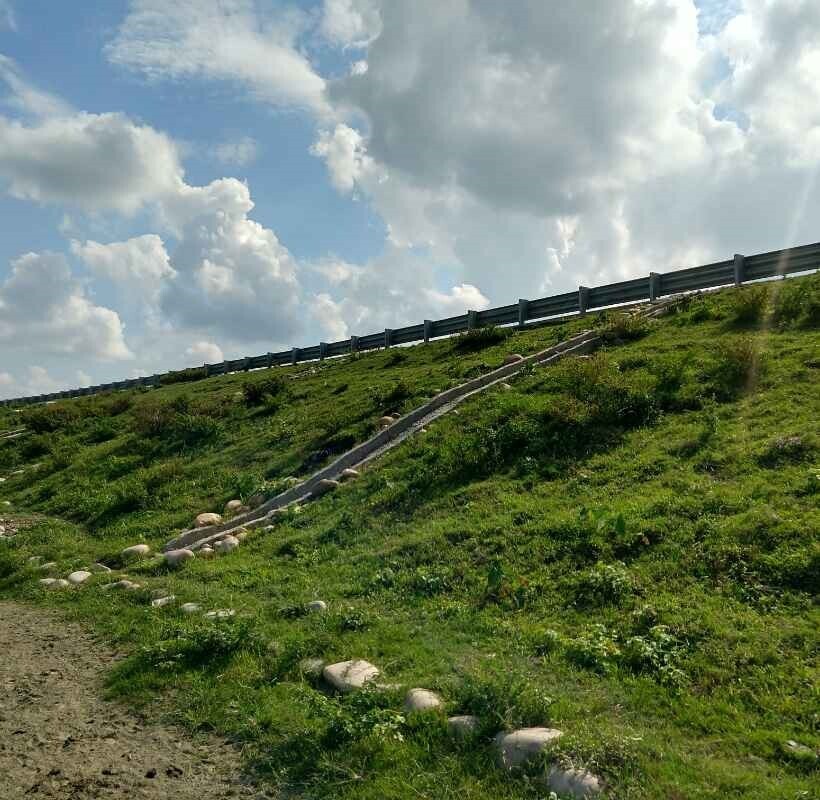Geogrid reinforced embankment
What is geogrid reinforced embankment?
Geogrid reinforced embankment refers to using geogrids, which are geosynthetic materials that enhance the tensile strength of the soil, to reinforce embankments. Geogrids improve the stability and bearing capacity of embankments. The application of geogrid in civil engineering started in the late 20th century. It brought about a big revolution in the advancement of methods of soil reinforcement in practice. Most of these materials are made from polymers like polyester, polypropylene, or polyethylene, which are durable and do not degrade under the influence of the environment. For example, geogrids are useful in stabilizing and reinforcing soil effectively in different applications for roadways, railways, and retaining walls.
Benefits of geogrid reinforced embankment
The benefits of geogrid-reinforced embankments include:
- Reduction of differential settlement: Geogrid reinforcement provides improved stability with soil arching in the embankment, thereby reducing differential settlement on the embankment surface. In the model test, this difference can be reduced by a significant value of 20 to 30 mm.
- Enhanced serviceability: Geogrid provides improved serviceability of the widened embankments due to the control of differential settlement, provision of stability, and improvement in overall performance.
- Improved stability: Geogrid reinforcement results in the stability of the embankment, especially in soft or clayey regions, which offer low strength against settlement, therefore increasing the embankment’s carrying capacity.
- Uniform settlement: Geotextiles or geogrids in embankment reduce the chances of non-uniform settlement, thereby making the overall structure stable.
- Earthquake resistance: Geogrid reinforcement helps mitigate settlement even under earthquake conditions. It has been observed that geogrid reinforced embankments revealed less settlement during an earthquake event.
In general, geogrid-reinforced embankments provide a more economic and efficient approach to enhancing the structure’s stability and reducing settlement in embankment structures, particularly for widening projects and in areas where the soil provides challenging conditions.
How is geogrid reinforced embankment constructed?
Geogrid-reinforced embankments are constructed by placing horizontal layers of geogrid reinforcement within the embankment fill to improve stability and reduce settlement. Here are the key steps:

- Prepare the foundation soil by removing any unsuitable material and compacting the surface. A geotextile separator may be placed on the foundation to prevent soil mixing.
- Lay the first layer of geogrid at the base of the embankment. The geogrid should extend beyond the toe of the slope to provide anchorage.
- Place and compact the embankment fill over the geogrid layer. The fill material is typically granular soil compacted to a high density.
- Repeat steps 2-3, placing additional horizontal layers of geogrid at regular vertical intervals, typically 2-6 feet, as the embankment is constructed. The geogrid should be continuous and overlap at the joints.
- For slopes steeper than 45°, the geogrid can be wrapped around the face of the slope to provide additional facing stability.
- Vegetate the slope face to protect against erosion and sloughing. A geotextile separator may be used between the soil and wrap-around geogrid.
The reinforcement increases the embankment’s stiffness, reduces shear stresses and strains in the foundation soil, and limits lateral spreading and settlement. Geogrid-reinforced embankments are commonly used over soft, compressible soils to improve stability and control deformations.
Applications of geogrid reinforced embankment
Geogrid-reinforced embankments have several key applications:
- Widening highway embankments: Geogrids can be used to strengthen the connection between the widened and old parts of a highway subgrade, preventing differential settlement.
- Constructing steep slopes and walls: High-strength geogrids allow for the construction of steep embankment slopes and retaining walls by providing reinforcement and stability.
- Crossing areas with soft soil: Geosynthetic-encased sand columns can be used to bridge areas with soft, compressible soils, improving stability and reducing settlement.
- Bridging areas susceptible to sinkholes: Geogrids with additional monitoring features, such as integrated chips and sensors, can be used to permanently monitor deformations in areas prone to sinkholes.
- Reinforcing bridge abutments: Geogrid-reinforced constructions are used for the construction of bridge abutments, providing reinforcement and stability.
Geogrid-reinforced embankments offer significant advantages over traditional concrete structures in terms of economic and ecological aspects. They also exhibit higher bearing capacity and lower deformations than expected, indicating that the compound behavior of geogrid and soil is not yet fully understood.
Therefore, geogrids are highly effective in their purpose of soil stabilization and settlement reduction and come at a reasonable cost while providing environmental benefits in modern construction technology. Since geogrids improve the structural integrity and assure long-term stability of embankments, they yield more safe and sustained infrastructures in various applications from roads and railways to landfills and coastal protection.
Strata Global’s geogrid-reinforced embankments deliver unparalleled stability, reduced settlement, and improved performance. Our innovative geogrid technology provides cost-effective solutions for sustainable and resilient construction. Get in touch with us today to transform your projects with geogrid reinforcement.
